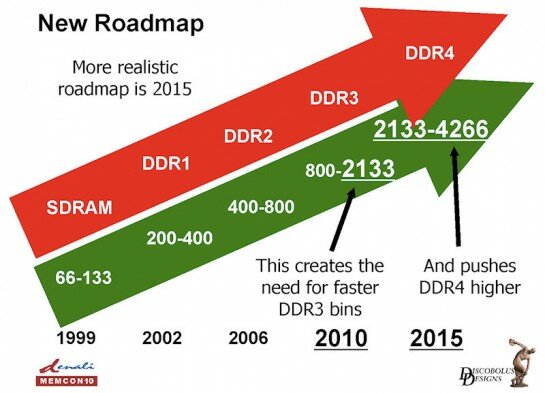Looking to the future, DDR3 will be around for a few years still so your recent or even upcoming memory purchases are still an investment, although Japanese website PC Watch has obtained a few slides on the next generation of SDRAM technology: DDR4.
JEDEC – a committee of industry members that hammer out the specification of all PC memory – will finalise the details next year, so right now the information is more in the “ideas” stage before everyone agrees to it. Once ratified, it’ll go into initial production in 2012 with mainstream acceptance all the way into 2015. We’ve still got a way to go – but remember that DDR3 has been around in some form since 2007, and it’s only this year we’ve seen DDR3 sales greatly over-riding DDR2 – mostly because of Intel’s adoption with its mainstream LGA1156 CPUs.
Super Speed!
DDR4 is set to bring a raft of changes to the design of memory that will let it scale to 4.2GHz (and likely beyond). In comparison, most DDR3 is sold at 1,333MHz or 1,600MHz and ultra high performance hits range above 2-2.5GHz these days. So DDR4 is set to double the highest of the high performance DDR3 and will be introduced at speeds of 2,133MHz. Wow!
Not only that though, but we’re also going to see yet another voltage reduction to 1.1-1.2V. Right now, most DDR3 is 1.5-1.65V (down from 1.8+V with DDR2), but newer “low power” DDR3 ICs can operate at just 1.35V, albeit at a sub-2GHz performance. Clearly some clever engineering is going to be needed to simultaneously reduce the voltage and increase performance.
Sounds Great, but is it really all that?
In order to achieve such lofty goals a change limitation seems like we will only be afforded a single memory stick (DIMM) per channel. Right now we can have two per channel, which means we can double the capacity by just adding one more memory kit. With one DIMM per channel it means less (questionably ugly) slots on the motherboard but less future memory upgradability, unless you replace your memory entirely with higher density parts.
TSV is the future!
To compensate for such an issue the memory manufacturers will use a technique called chip stacking – with a specific new technology call TSV, or Through Silicon Via. To put it simply, this is where memory dies (the silicon bit that holds the data) get layered on top of each other to increase the capacity at the expense of making the memory chips a little thicker. To connect it all up they have vertical pillars that shoot right through the middle of them so the electrodes in the bottom can talk to all the dies in the stack. Very clever!
The old way of memory stacking was to have multiple, extremely tiny metal (usually gold or copper) wires connecting up to the edges of each individual die. The end result is an extremely delicate and engineering intensive product (read: very high cost), so not suitable for a mass market application, which is why the TSV method was developed.
How does this affect your PC?
Right now it doesn’t, so don’t worry about it. DDR3 is still mainstream for several more years and DDR4 isn’t even on Intel’s or AMD’s CPU roadmaps yet. When it does arrive we’ll get a lot more memory bandwidth for our brand new computer parts, but at the expense of making a firm decision of exactly how much memory we will need. That’s not a big issue though as big jumps in memory needs take years to transition from “nice to have” to “is now useful” to “absolutely needed”, so replacing your PC memory with more capacity will likely co-incide with a frequency and performance bump too. That’s win-win.
You May Find These Interesting
-
purushothaman


